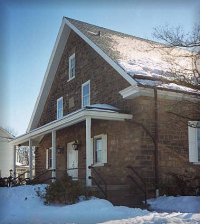|

Doylestown was incorporated as a borough in 1838.
History of Borough -
Doylestown (Towship) was organized in 1818 and situated within a mile of the geographical centre of the county. By an Act of Assembly, passed the 20th of March, 1724, became the county seat in place of Bristol, an honor which it held until 1812, when the courts and public offices were removed to Doylestown, a more central location.
In 1912, one hundred years later the centennial was celebrated by decorating the streets, patriotic flags, and a costume ball, to name just a few of the events. BCHS
Doylestown, the county seat, was first called by this name in 1778.
It is derived the name from William Doyles, who settled there about
1735, and kept a hostelry at the cross-roads as early as 1742. The
earliest inhabitants of the neighborhood were Scotch-Irish. In 1732 a
log church was founded at Deep Run, eight miles north-west of
Doylestown, of which Rev. Francis McHenry was installed pastor in
1738. Doylestown was incorporated as a borough in 1838. A flourishing
boarding school for boys and girls has been established here by a
joint stock company, and also a prosperous female seminary. Newspaper
authority tells us that Doylestown, in 1778, contained but two or
three log dwellings. Early settlers: Joseph Kirkbride, William Doyle, David Thomas,
William Wells, Thomas Adams, Thomas Morris, John Marks, Hugh Edmund,
Clement Doyles, William Beal, Joseph Burges, Nathaniel West, William
Dungan, Solomon McLean, David Easton, and Edward Doyle, Christian
Wertz, George Stewart, Doctor Meredith, Jacob Thomas, Eli
Vanluvanee (shoemaker). The oldest families of Doylestown,
Harveys, Stewarts, McIntoshes, Vanluvanee, Halls, Magills, and the
DuBoises. In 1820 the population of Doylestown was but 360, and about
500 in 1829. One account tells us the population was 800 in 1830.
According to the census of 1840 the population was 906; 1850, 974
white and 32 colored; 1860, 1,416, and 1,601 in 1870, of which 139
were of foreign birth. The actual population is about 2,000. The First Baptist church of Doylestown was
organized on the evening of Thursday, December 3, 1867, with
the election of Reverend W.S. Wood as pastor, and two
deacons- Robert Johnson and James D. Scott. There were more
than fifty constituent members, a majority of whom had
formerly been connected with the New Britain church. It was
recognized as a regularly constituted organization January
16, 1868, by a council composed of representatives of seven
different Baptist churches, Dr. George Dana Boardman
delivering the sermon on the occasion; and at the next
meeting of the North Philadelphia Association this church
was formally admitted into the body. The initial step in
building a church was taken January 12, 1867, when a
committee was appointed to purchase a suitable site. Within
two years from that date the proposed building was under
roof; but owing to financial stringency it was not dedicated
until January, 1877. It is a substantial structure, eligibly
located, commodious, well furnished, and involved an
aggregate expenditure of twenty-three thousand dollars. The
successors of Mr. Wood as pastor were: Reverend H.A.
Hastings, John Miller, and T.R. Howlett. The membership
numbers one hundred and seventy-five at present. Battle History of
Bucks County, page 460 |
 |
ALMSHOUSE HILL |
 |
BENNETTS CORNER |
 |
CASTLE VALLEY
Two miles southwest of Doylestown on Neshaminy Creek at the intersection of Almshouse and Lower State Roads. Once a part of Warwick, it was included in Doylestown Township in 1819. In colonial times it was known as Bartons Ford, so named for Thomas Barton, a nephew of Walter Shewell, founder of Plainswick Hall a short half mile from Castle Valley. Barton bought this tract of 200 acres on the east bank of the Neshaminy from the executors of Jeremiah Langhorne in 1750. Bartons Ford may have been the name of this locality down to 1835, when the covered bridge was built to carry the Lower State Road over the creek. The name was then changed to Castle Valley.
Place Names in Bucks County, Doylestown, Bucks County Historical Society, Doylestown PA, 1942-George MacReynolds
Castle Valley Mill - A Bucks County mill is reborn, originally built in 1730 |
 |
James Lorah house |
 |
Dyerstown
The site was developed by John Dyer, an English Quaker. At that time, the town was called Dyerstown. The mill has served as a post office, general store, an inn (around the time of Prohibition) and then a tavern. While changes have been made to the building, it retains its historic appeal. This site is now the Waterwheel Restaurant on Old Easton Road
|
 | Does anyone have any information
on a cemetery called Cross Keys Cemetery or Old Day
Cemetery, located off of Dublin Pike, above
Doylestown. I was wondering if there are records
available. |
 | Edison originally known as Bridge Point
|
|
 |
Photographic Tour Doylestown |
| |
http://www.sbcod.org/pages.asp?pageid=108338
THE HISTORY OF SECOND BAPTIST CHURCH OF DOYLESTOWN
The history of the Second Baptist Church of Doylestown dates back over a period of 104 years, having its roots in the St. Mark C.M.E Church, Doylestown, PA. Records show that this church, also known as the "People's Colored Church of Doylestown," was chartered on April 29th 1874 |
|
![]()